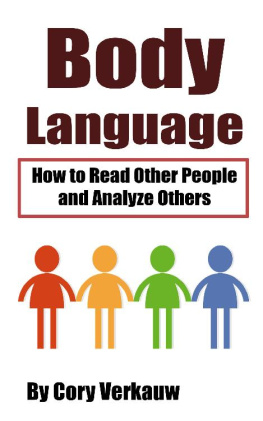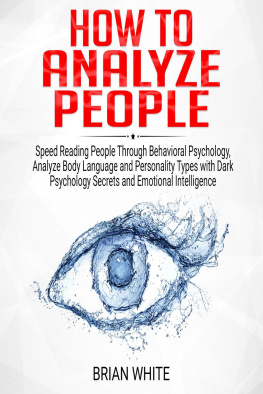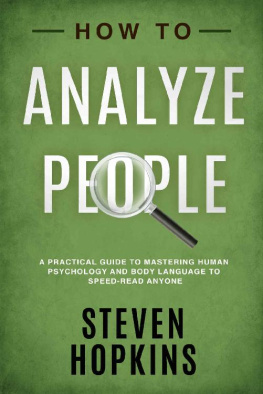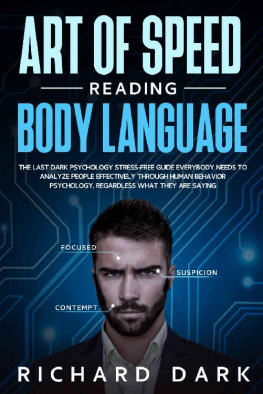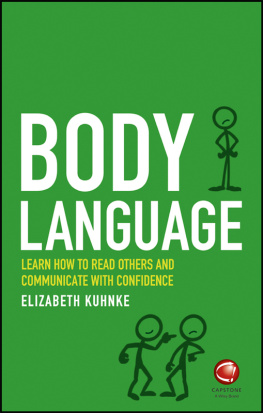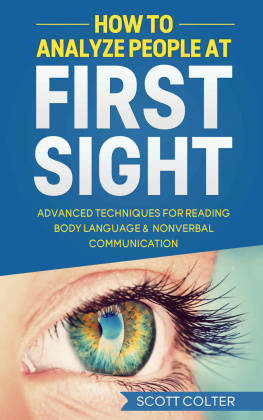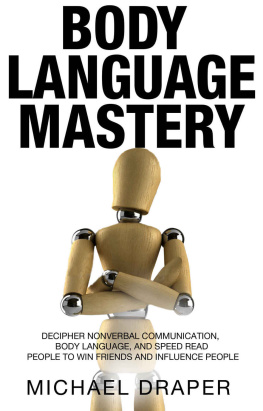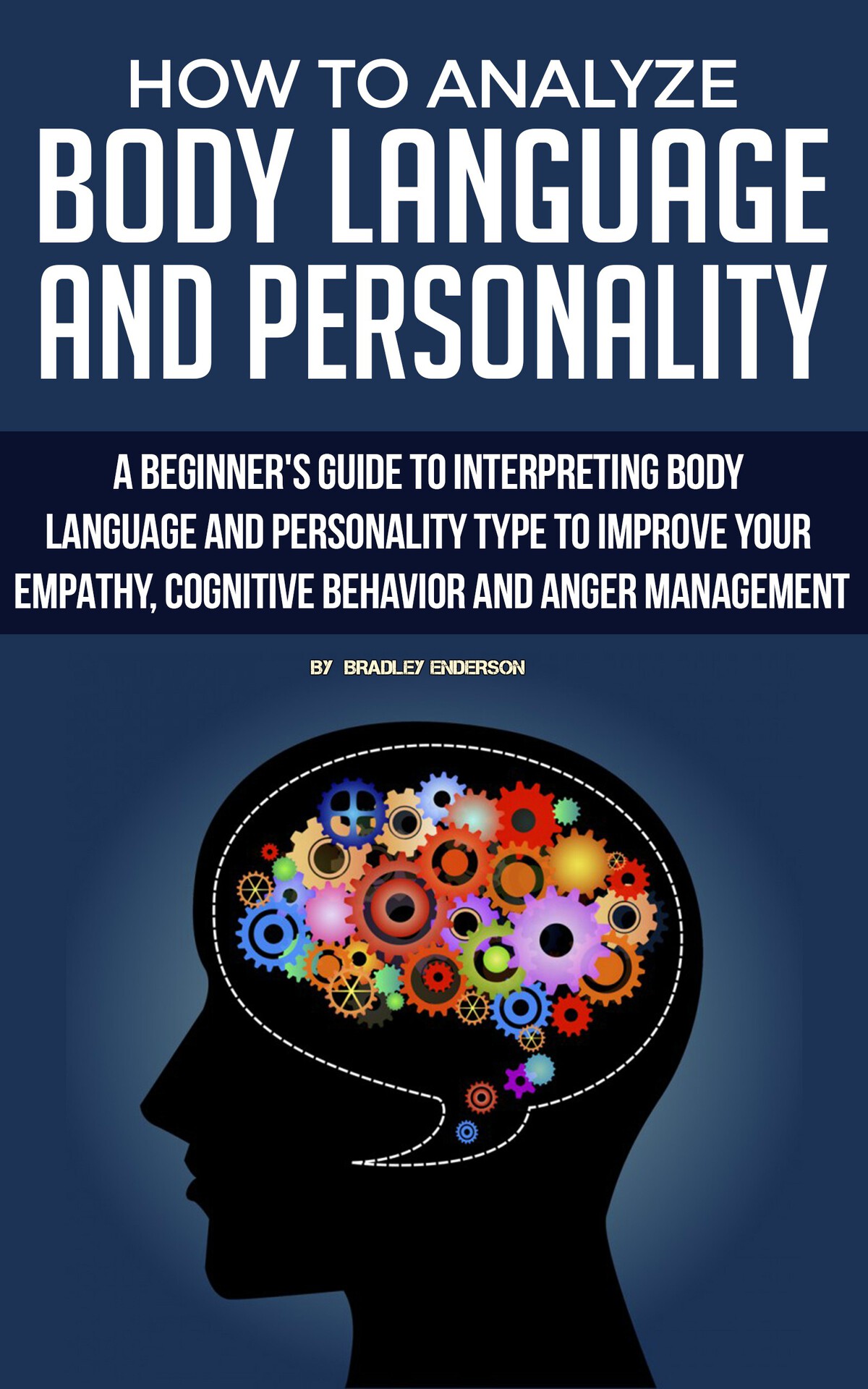How to analyze body language and personality
(A beginner's guide to interpreting body language and personality type to improve your empathy, cognitive behavior and anger management.
Copyright 2020 by Bradley Enderson All rights reserved.
This document is geared towards providing exact and reliable information with regards to the
topic and issue covered. The publication is sold with the idea that the publisher is not required to
render accounting, officially permitted, or otherwise, qualified services. If advice is necessary, legal
or professional, a practiced individual in the profession should be ordered.
- From a Declaration of Principles which was accepted and approved equally by a Committee of
the American Bar Association and a Committee of Publishers and Associations.
In no way is it legal to reproduce, duplicate, or transmit any part of this document in either
electronic means or in printed format. Recording of this publication is strictly prohibited and any
storage of this document is not allowed unless with written permission from the publisher. All
rights reserved.
The information provided herein is stated to be truthful and consistent, in that any liability, in
terms of inattention or otherwise, by any usage or abuse of any policies, processes, or directions
contained within is the solitary and utter responsibility of the recipient reader. Under no
circumstances will any legal responsibility or blame be held against the publisher for any
reparation, damages, or monetary loss due to the information herein, either directly or indirectly.
Respective authors own all copyrights not held by the publisher.
The information herein is offered for informational purposes solely, and is universal as so. The
presentation of the information is without contract or any type of guarantee assurance.
The trademarks that are used are without any consent, and the publication of the trademark is without permission or backing by the trademark owner. All trademarks and brands within this book are for clarifying purposes only and are the owned by the owners themselves, not affiliated with this document
Preview
Chapter one
Introduction to body language
Body language Principles
Body language That Demonstrates Attraction
Chapter Two
The Law of Attraction
The Single Most Attractive Trait
Attractive Body Language
How to Know Whether Someone is Attracted to You
How to Be Attractive Nonverbally
Chapter Three
The Power of the Purse
Physical expressions
Subcategories
Manner of speaking
Universal and cultural specifications
Social identicalness model
Social preferred position model
Applications
Second-language securing
Chapter Four
Introduction to personality
Humoral hypotheses
Psychoanalytic Theories
Personality statistic Theories
Present-day Trends in Personality Studies
Chapter Five
Measurements
Five-factor stock
Formative organic model
Ecological impacts
Diverse examinations
Chapter Six
Introduction to anger management
Fantasies and realities about resentment
How anger the board can support you
Potential causes for the development of problems
Other proof-based methodologies
Chapter Seven
Types of personality
How to observe body personality
A Big Five Journey
Step by step instructions to Apply Personality-Type Information
Eight ways to read someone's body language
How can you boost your cognitive ability
Chapter Eight
What is cognitive behavioral therapy and NLP
What is NLP
How Neuro-Linguistic Programming Works
Neuro-Lingustatistic Programming In Therapy
Benefits of personality analysis
What is the significance of Personality Testing?
Preview
Body language is a method of nonverbal communication in which the meaning is conveyed or communicated through bodily actions as opposed to words. This behavior includes expression of the face, the stance of the body, gestures, movement of the hand, touch and space use. In both animals and humans, body language exists, but this article focuses on interpretations of the language of the human body. It's also called kinesics.
Body language should not be confused with sign language, because sign languages are complete languages such as spoken languages and have their own complicated grammar structures, as well as being able to display the fundamental properties that occur in all languages. Body language, on the other hand, does not have a grammar structure and must be understood loosely, rather than having an absolute meaning relating to it.
There are agreed-upon interpretations of a specific behavior in a society. Interpretations can differ from country to country, or from culture to culture. On this topic, there is debate about the universality of body language. Body language, a nonverbal communication branch, complements social interaction with verbal communication.
In addition, some researchers conclude that nonverbal contact accounts for most of the information exchanged during interpersonal interactions. This helps to define the connection between two individuals and governs behavior, but can be unclear.
It is the knowledge of the character by the features of the face and hand. It is about moving from an empirical art to an observation science. The character is not independent of the physical constitution. It is conditioned by the state of our body, as on the other hand, the body is influenced by the emotions of the soul.
Life is due to a double movement: a dilation movement and a conservation movement; which allows analyzing the personality of any human being.
The Dilation-expansion: It is characterized by its adaptability to the environment, an externalization of intuitive and affective tendencies, sociability, cheerful humor, need to be in groups, intelligence adapted to the useful and directed to practical realizations.
The Conservation-Seclusion: It manifests itself in the opposite way, with an elective adaptation to a privileged environment. Since withdrawal is a defense process, it acts only in a medium that does not suit you.
While the expansive individual is a friend of the whole world, disperses his activity in all directions, reacts impulsively, is determined and has a sensory intelligence of immediate contact, the withdrawn has only friends of choice and if he does not have them he prefers loneliness , he concentrates and is only active in some directions, it is not resolved unless he has reflected, does not trust his sensory impressions and is more idealistic replacing reality with abstractions, distrusts his senses and his reason.
The Expansive individual: It is characterized by having a thick structure, colored and warm skin, wide round face, large mouth, snub nose, large eyes and smiling expression, with ease and abundance of exchanges.
The retracted individual: It is thin in nature, short limbs, dry and cold skin and pale dye. The face is elongated, narrow and bony, it is parsimonious, selective in the exchanges, small mouth, narrow and bony nose, sunken eyes, hermetic face and little communicative.


